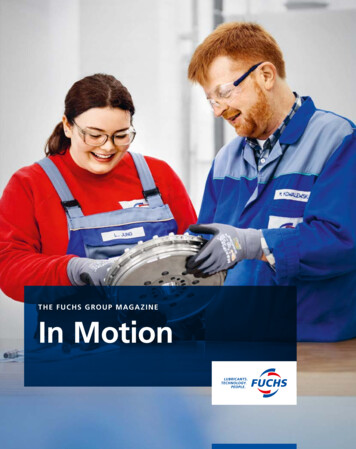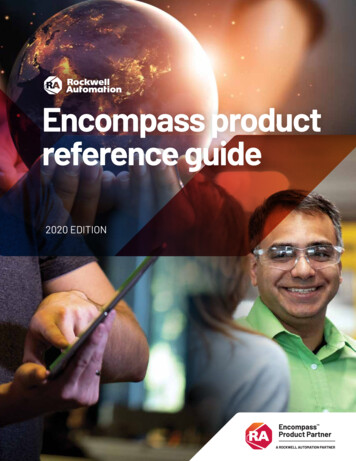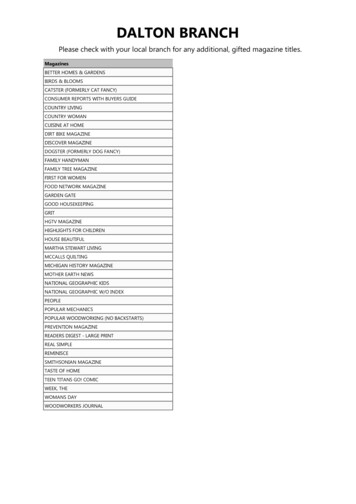
Transcription
T he FUC HS G rou p m ag a z i n eIn Motion
Contentslubricants. technology. people.OUR BUSINESS MODEL – for over 85 years // 4F UCHS WORLDWIDE – more than 100,000 customers in over 45countries around the world // 6 IN MOTION – for the Chairman of the Executive Board, Stefan Fuchs, thecompany’s adaptability is a significant factor in its success // 142016 IN MOTION – our highlights of the year // 30FACTS AND FIGURES // 38lubricants.F UCHS: HELPING YOU IN DAY-TO-DAY LIFE – FUCHS products are used ina diverse range of everyday objects. A brief insight. // 18 A STRONG BOND – FUCHS LUBRITECH offers a comprehensivelubricant and service concept for the Beckum-Kollenbach cement plant –an exemplary partnership // 24technology. W ASTE TO VALUE – from old frying fat to sustainable and high-qualityraw material – FUCHS conducts research in the ZeroCarb FP strategic alliance // 8PEOPLE. G LOBETROT TER – from southwestern Germany to the world’s third-largest city:Product Manager Daniel Henn works for FUCHS in Shanghai // 32
» The world is changing at arapid pace; networked society is increasing the pace.More than ever, we are acting as an agile companythat sees this change as an opportunity. Global marketsand technologies are changing at extreme speed. Wecreate value for our customers, partners and shareholderswith our globally defined brand and the promise ‘technology that pays back’. For us, it is clear that you can onlybe a global leader by being dynamic. We are always inmotion. «Stefan Fuchs Chairman of the Executive Board
4LUBRIC ANTS. T E C H N O L O G Y. PEOPLE.Our business model –for over 85 yearsLUBRICANTS. TECHNOLOGY. PEOPLE. Our company rests onthese three pillars. As a mission statement, they are the basis forour daily activity around the world and simultaneously the coreof the FUCHS brand.LU BRIC ANTS. 10 0 % FOcUSWorldwide, FUCHS focuses 100 % on the development, manufacture, distribution,and sale of high-quality lubricants and related specialties for nearly all applicationsand industries. With over 10,000 products, we offer our customers a full portfolioof lubricants that comply with exacting national and international standards.
LUBRIC ANTS. T E C H N O L O G Y. PEOPLE.T E C H N O L O G Y. H O L I S T I C S O L U T I O N STechnologically advanced, process-oriented, andholistic lubricant solutions are a key success factor forFUCHS. Our worldwide network of experts meetscustomer requirements on a global scale by quicklyand efficiently networking fields of special expertise.We strive to be the technology and innovation leaderin important business areas. Our approach focuseson effectiveness and efficiency, safety and reliability,and the sustainability of lubricants along the processand value chain with regard to supplier, raw materials,production, and the end product.PEOPLE. PERSONAL COMMITMENTAlmost 5,000 highly qualified and specializedemployees worldwide are committed to FUCHS .Our global team regards itself as a well-coordinatedunit, whose personal commitment continues towrite new chapters in our company’s success story.Intensive dialog with our customers and partnersand trusting and fair collaboration enable us toalways find the optimum, tailor-made lubricant solution to meet the individual requirements of our customers.5
6LUBRIC ANTS. T E C H N O L O G Y. PEOPLE.FUCHSworldwideWe are where our more than 100,000 customers need us –in over 45 countries around the globe. This local presence andour employees with their extraordinary know-how form thebasis of our success. In 57 operating companies and 34 plants,they communicate every day in order to network their expert knowledge.
LUBRIC ANTS. T E C H N O L O G Y. PEOPLE.5734operating companiesworldwide production locationsworldwide5Germany8Germany26Other European countries8Other European 4North America7North America2South America2South America7
8LUBRIC ANTS. T E C H N O L O G Y. PEOPLE.Microscopic image of a small colony of yeast fungi. The single-cell yeastfungi are able to synthesize oils, which makes them highly interestingobjects of research in the ZeroCarb FP project.
LUBRIC ANTS. T E C H N O L O G Y. PEOPLE.9Wasteto ValueRenewable raw materials are all the rage rightnow, but the ZeroCarb FP research alliance isgoing one step further. They want to make certainkinds of waste the basis of high-value products.FUCHS is working with project partners to, amongother things, obtain key components of differentlubricants from old frying fat using an innovative,resource-conserving process.By Ulrich PontesThe word “ZeroCarb” is printed on the white pot, which, judging by its shape, looks like it could contain face cream. Thelaboratory technician uses a spatula to scoop up a small amountof grease and spread it on a small metal plate. This is part ofa piece of equipment on the laboratory bench, which from a distance resembles a food processor – but with a connected control PC . The laboratory technician presses a button to startthe measurement: A second metal plate slides down ontothe grease and, almost imperceptibly, starts to rotate.The head of advanced development at FUCHS SCHMIERSTOFFEGmbH in Mannheim is standing next to her, talking excitedlyabout everything that this relatively simple-looking piece of equipment can do. The equipment in question is a rheometer, whosename is derived from the Greek word for “flow.” “Many lubricants are not merely viscous; they have a small elastic component, too.” He places the palm of one hand loosely on the otherand turns them against each other. “If you twist a layer of lubricant like this, there is a tiny amount of restoring force.” This iswhat the rheometer measures when it rotates the plates, with
10LUBRIC ANTS. T E C H N O L O G Y. PEOPLE.precisely predefined parameters such as plate distance and temperature. “The lowest possible speed is two rotations per year.Per year!” emphasizes the department head.Ultimately, the head of advanced development continues, rheometer testing like this combines multiple standard test procedures for lubricants in a single, automated measuring process.As such, this process is a key element of what he and his staffwant to achieve: The developers want to see whether thelubricant in the rheometer – with the first full prototypes fromthe ZeroCarb research project (see “The ZeroCarb FP strategicalliance”) – behaves exactly as predicted.An unusual genesisThis might sound unspectacular, but it is an amazing achievement because the ZeroCarb product represents a majoradvance in terms of sustainability. Thanks to a new synthesisprocess, one of its key constituents can be obtained fromanother, sustainable resource: used cooking oil. “In other words,the stuff that chip shops and restaurants up and down thecountry produce every day as waste,” says the head of advancedThe ZeroCarb FPstrategic allianceThe name stands for “zero-carbon footprint”, whichthe research alliance is aiming to achieve throughthe recycling and biotechnological r efinement ofcarbon-containing waste streams. The subprojectteams focus on different areas including wastewater,exhaust gases and byproducts of biodiesel production. Since 2013, this a lliance – which, in additionto FUCHS SCHMIERSTOFFE GmbH and BRAIN AG ,includes several other companies from a range ofdifferent industries – has been sponsored by theFederal Minis try of Education and Research as partof the “Industrial Biotechnology” initiative.9 years– that’s how long the project is expected to last.The project is divided into three phases, withphase two already approved and launched at theend of 2016.development. This completes the cycle of materials in an ecofriendly manner. Renewable raw materials mean that we nolonger have to choose between “food or fuel”, because now wecan have “food then fuel.” But the focus is not just on lubricants: The aim of ZeroCarb is to produce other materials, witheven more flexible uses. “For FUCHS , this could ultimately represent another major step away from fossil fuels toward sustainably produced raw materials,” continues the head of advanceddevelopment, emphasizing the strategic aspect.The process of refining old frying fat to create a high-qualityraw material involves two steps. The first step, in which the fatmolecules are split open, is common practice in biodiesel production. The second step, however, is highly innovative and wascompletely redesigned from the ground up for the ZeroCarbproject. An enzyme – a biochemical catalyst produced from living organisms – plays a key role here. “We exploit the synthesisactivity seen in the natural world,” says the head of advanceddevelopment.To find out more about the background to this particular step inthe production process, you have to travel a good 30 kilo metersnortheast from the FUCHS laboratories. In a protected industrial,Bauhaus-style building in the attractive town of Zwingenberg,which lies on the Hessian Bergstrasse, are the headquarters ofBR AIN AG , in a converted Fissan powder building. This researchfocused biotechnology company is a project partner of FUCHS .Refrigerators full of bacteria and algaeWe are first led into a nondescript underground room containing perhaps a dozen wide refrigerators. “This is the heart ofBR AIN AG – our bioarchive,” explains Dr. Wolfgang Aehle. Thehighly experienced chemist is responsible for corporate devel opment in the field of performance proteins and enzymes. “Theserefrigerators contain our collection of microorganisms andmicroalgae – in total, around 53,000 different strains isolatedfrom, for example, ground or water samples.”These largely un-researched bacteria, yeasts and algae producecountless enzymes to help them biochemically convert molecules from their natural environment for their own metabolicprocesses. But some of these enzymes are potentially viablefor technical applications. In domestic products, for example, theycan help to increase the stain removal properties of washingagents; or they can modify organic molecules from certainkinds of waste so that they can potentially be used in the production of lubricants.
LUBRIC ANTS. T E C H N O L O G Y. PEOPLE.Dirk Bogaczyk,employee from the River Emscher water management association (Emschergenossenschaft) inEssen and overall coordinator for the first phaseof the ZeroCarbFP strategic alliance (2013 – 2016)Mr. Bogaczyk, what isthe goal of ZeroCarb FP?To ensure the practicability of this application, the expertsin Zwingenberg first need detailed input, which is to come fromthe enzyme. This input was provided, in this case, by theFUCHS advanced development team, explains Dr. Birgit Heinze,ZeroCarb project manager at BR AIN . And now this is wherethe expertise of the biotechnology specialists comes in. “The firststep is screening,” says the project manager. This is a processthat involves identifying potential enzyme candidates and producers, for example using microorganisms that the researchersknow possess the ability to functionalize fatty acids. One doordown, in the molecular biology laboratory, the microorganismsare cultivated and then tested for their ability to produce therequired molecule.The goal is essentially to create a closed, highly effectivecarbon cycle. To achieve this, carbon compounds from industrial waste and byproduct flows are to be biotechnologicallyconverted – that is, using microorganisms – into new resources.We are experiencing a raw material revolution. Many industries are trying to reduce their dependence on petroleum,switch to sustainably produced raw materials and employ alternative, ecofriendly processes. Politicians are supporting thisrevolution with the “National Research Strategy BioEconomy2030”, which was initiated in 2010. And given global economic and population trends, this revolution cannot come soonenough. The demand for food is expected to double by2050, as is the volume of waste; in addition, the volume ofbioplastics is expected to triple.“This qualitative preselection process is followed by the quantitative examination,” continues Birgit Heinze. This processinvolves clarifying, for example, exactly how and how effectively the enzyme works. “Parallel to this, we start to developthe actual biocatalytic process.” To simulate the technical process in which the enzyme is to convert the raw material intothe final product, the scientists use a SpinChem reactor – asaucepan-sized glass container with a stirrer and perforatedchamber attached. This contains the enzyme, which is on a carrier material. “Here we can see, for example, how stable theenzyme is,” says the project manager.What, specifically, is the team researching?The team is working in different areas. For us in the waterindustry association, we are, of course, interested in the processes involved in extracting carbon and other resourcesfrom wastewater. Other subprograms are focused on, for example, glycerin, a residual product of biodiesel production, whileothers are focusing on carbon dioxide in flue gas. With the helpof biotechnological processes, these resources are to beused to produce flexible platform chemicals, bioplastics andThe challenge of upscalingUsing different methods, the researchers can optimize the performance of the enzyme, for example by promoting the evolutionary development of the original microorganism in the hopethat the enzyme, too, will evolve and become more effective.“At the same time, we have to develop a second process: thebiotechnological production of the enzyme itself,” says Wolfgang Aehle. It is not generally the original organism that is usedhere, but instead a well-researched production organism suchas coliform bacteria. “Into this we transfer the genetic blueprintfor the desired enzyme so that the organism can then producethis enzyme.”additives for lubricants.What are the biggest challenges?In the field of biotechnology, upscaling is always tricky. In theresearch phase, producing quantities in the milliliter or milligram range is generally considered an achievement. We do notyet know whether and how processes can subsequently beupscaled to the liter or even cubic-meter range. Another challenge is to leverage synergies. Previously, the subprogramsoperated relatively independently, but now we have to fostera collaborative mindset and use processes and systems fora variety of applications and resource streams. This is closelyconnected with the third major challenge. Ultimately, it’snot enough simply to develop processes that function. Theyalso have to be economically competitive and, ideally, remaincompetitive even in the face of ever-changing conditionssuch as fluctuations in the price of oil or demand for certainspecific raw materials.11
12LUBRIC ANTS. T E C H N O L O G Y. PEOPLE.How can we improve these oils so that we are even better equipped todeal with upcoming technological advances? The head of advanceddevelopment talks to his team leader. Her tasks include coordinatingthe ZeroCarb activities at FUCHS.Preparations for a rheometer analysis to ascertain the properties of the lubricant.The smaller picture shows the second, rotating plate in its start position for themeasurement. Then the black cover is lowered, meaning that you can no longersee the measurement plates. The cover ensures that the temperature can be regulated to predefined values.
LUBRIC ANTS.The BR AIN employee opens the door to another laboratory,where we can see not just small glass reactors, but also vast steelvessels, the biggest of which is several stories high. Aehleexplains: “One major challenge is upscaling. When the microorganisms grow as we want them to in a one-liter fermenter,this does not necessarily mean that the process will also functionon a larger scale.” The researchers at BR AIN want to controlenzyme production in a fermenter with a capacity of least 200liters before approving the process for industrial-scale production.Close-up of a piece of apparatus for special, long-term stability testing. T E C H N O L O G Y. PEOPLE.13Over the course of the three-year project research phase,which has just come to an end, even the production of just onekilo of raw material may be considered a success. “We neededaround three grams of enzymes for that,” says Birgit Heinze. AtFUCHS in Mannheim, however, this one kilo of raw materialhelped to produce several kilos of lubricant. “In preliminary experiments, we worked with just 10 grams and more of raw material. To produce such tiny quantities of lubricants, the colleaguesstood there with a thermometer for one or two hours and didthe stirring themselves,” explains the advanced developmentteam leader, who is coordinating the ZeroCarb project at FUCHS .“And in the pre-development phase, our state-of-the-art measuring techniques mean that, even with just a few grams,we can conduct highly informative investigations.”Crucial to this is the aforementioned rheometer. In just a fewsimple steps, it can be modified for tribometric tests – thatis, measurements where friction and wear also play a role. “Onthe basis of these results, state-of-the-art simulation methodsallow us to make astonishingly accurate predictions for real-lifeapplications,” says the head of advanced development. Andthis is why he has no doubt that ZeroCarb lubricants will fulfillall functional requirements. Nevertheless, proper applicationtests are still necessary for demonstrating compliance with allspecifications. These become possible in the next scaling step,i. e. with around 50 kilos of raw material.But there’s another soon-to-be-addressed aspect that the lubricant developer finds even more exciting: the minimum requirements. The team leader asks a crucial question: “How pure dothe raw materials have to be? This will ultimately determinethe price.” So in addition to all the technical activities, anotherchallenge facing FUCHS and its partners during the scheduledproject runtime up to 2022 will be to address the various economic issues, which have so far not been considered in anygreat detail.
14LUBRIC ANTS. T E C H N O L O G Y. PEOPLE.INMOTIONFUCHS, number one among independentlubricant suppliers, has been growing constantlyfor years. The Chairman of the Executive BoardStefan Fuchs sees the ability to adapt as an important factor in this success and explains whereFUCHS is currently moving and changing.By Silke WernetMr. Fuchs, how would you assess the financial year 2016?We are very pleased that we have followed on from 2015,when we exceeded the two-billion mark for the first time, withsales revenues of 2.3 billion in the past financial year. Ourgrowth in sales revenues in 2016 was dominated in particular bythe large acquisitions DEUTSCHE PENTOSIN -WERKE GmbHand STATOIL FUEL & RETAIL LUBRICANTS (SFRL ), which areboth included over the full twelve months for the first time.Our organic growth was mainly in Europe, especially in Germanyand Eastern Europe. Also in Asia, especially in China and India,we achieved very good results. We made important changes forthe future in America – including the expansion of our productportfolio, two smaller acquisitions and large investments at theChicago site.» Over more than 85 years, wehave always responded quicklyto changing market conditionsand used this to our advantage.We were and are always inmotion. «Stefan Fuchs Cha i rman of the E xecutive Boa rdIncluding 2016, your company has therefore increased itsearnings for the eighth time in a row. Why is FUCHS such asuccess story?There are many reasons. In addition to our motivated team,a very important one is that we were and are always moving. Inour more than 85 -year history, we have always respondedquickly to changing market conditions and used changes to ouradvantage: After it was founded, our company was graduallyexpanded internationally up to the 1970s. It was by no meansan easy decision for our family to go public – but we tookthe chance to do so in 1985. After more than 30 years, we havea clean record: There hasn’t been a single year with a loss,and we have always been able to pay dividends. The IPO was followed by some major acquisitions around the world. Thisresulted in a mix of locations with the genuine FUCHS culture,such as China, where we established ourselves back in the1980s, and acquisitions that we had to integrate culturally andin terms of infrastructure. This was successfully accomplishedover the years.You have also made groundbreaking decisions in the morerecent past.The world is changing at a rapid pace. This change must beseen as an opportunity. We are therefore undergoing a processof change in which we have already taken crucial steps inorder to successfully overcome future challenges. For example,
LUBRIC ANTS. T E C H N O L O G Y. PEOPLE.15 300 million,which FUCHS will invest in its growth initiative by 2018 ,is the largest investment budget in the company’s history.About 100 million has already been spent in 2016.GERMANYDevelopments at the Mannheim and Kaisers lautern sites with warehouse and officeexpansions. The completion of the new testfield building considerably increasedresearch capacity in Mannheim.USAAs part of the 3C commitmentto offer identical grease forOEM customers on three continents, the production of 29different specialty greases willstart in the new factory in Harvey, Chicago, in February 2017.SWEDENThe planned factory will replacethe rented plant in a few years.SOUTH AFRIC AThe new grease plant near Johannesburgwill produce a diverse range of greasesstarting in summer 2017. State-of-the-arttechnology will allow South African customers’ constantly rising demands to bemet.CHINAIn Wujiang (Jiangsu province), a new80,000 -square-meter factory witheight filling lines, two warehouses and55 tanks – one of the most modernlubricant production facilities in China– will be built by the end of 2018.AUSTRALIAThe plant in Beresfield near Newcastle will commence operations inApril 2017. The new site guarantees continued proximity and efficient supply to customers in Australia.
16LUBRIC ANTS. T E C H N O L O G Y. PEOPLE.in 2012 we came up with the mission statement “LUBRICANTS .TECHNOLOGY. PEOPLE .” complemented by our values of trust,respect, reliability, creating value and integrity. This missionstatement also explains our business model: We are focused onthe world of lubricants and want to grow worldwide witharound 10,000 products. We still have enormous potential here,as well as in the field of technology, where we want to bethe clear technological driver. We connect our employees internationally and use regular network meetings to bring themtogether with other experts in their field from around the worldin order to promote the transfer of knowledge. This is one ofour major strengths. On the basis of our mission statement, wein the Group Management Committee defined the brandhouse in 2015 with FUCHS as the single umbrella brand for thewhole world. It is founded on the positioning as “my lubricants company” for all stakeholders and the clear promise to ourcustomers that we stand for technology that pays back. Ourvision is “being first choice”. Another important element of thechange process are the leadership principles, which we arenow rolling out worldwide.What is it?On the basis of our values, we have established six global lead ership principles relating to information sharing and knowledgemanagement, for example. We thus clearly define the leadership style with which our teams should be led worldwide, howwe ensure open communication free of hierarchies and howwe cooperate successfully across international borders. We knowthat we need to tread carefully on this issue when it comes toour employees and that individual countries have different conditions. This process will therefore take several years. In g eneral, we have determined that we are stretched to our limits withregard to communication in 60 companies and with morethan 1,000 new employees. We will therefore do a lot more inthe future to convey to our employees what FUCHS standsfor. The global intranet and a planned chat tool are steps in thisdirection.In a world that is turning ever faster, the issue ofdigitalization is also playing an ever greater role. How isFUCHS responding?Digitalization is affecting us in many areas, be it logistics, production, sales or the monitoring of our products with the customer. We have therefore established a think tank for this issue,a company that deliberately considers new approaches andadvances digitalization projects.What else is involved in the change process you mentioned?Because we believe the customer is king, we are working onevery level to ensure that our customers are satisfied. We aretherefore also working on a better balance between the triangle of sales, research and product management. Specifically,our industrial business will be represented by its own Vice President ( VP ) in the sales area in the future. And in order to bringproduct management onto an equal footing, we are creating anew VP position here too. While global Product Managers currently report directly to our Chief Technology Officer, the newVP will bundle their interests in the future.The continuously profitable growth is also an expression ofconstant change and simultaneously the consistency ofFUCHS. By 2018, you will invest 300 million into the growthinitiative. What is the motivation for this?We want to continue consistently expanding our global growthpotential. We are deliberately spending money today in orderto increase our future income. When choosing our investments,we look to the major growth regions of Germany, the USAand China. But we are also very interested in markets such asKorea, Russia, India, Turkey, Poland, Australia and South Africa.Our market shares here are sometimes markedly different, including between industries, and we are also looking for opportunities to strategically expand our business. We took such an opportunity, relating to the industrial oil business in the USA , in2016 by acquiring ULTR ACHEM INC .How can FUCHS’ success story be continued in the yearsto come?The global economic and political situation will remain tense.However, our broad-based business model is good at absorbinguncertainty. For example, the vehicle market accounts for onlya quarter of our activities. In addition to our wide range, the family values, which can be seen in the ownership structure, areanother stability factor. They guarantee our independence andallow us to set out a long-term and sustainable strategy. Besidesour high agility, we also have an absolutely stable foundation.We will therefore remain in a solid position and stick to ourchosen path.
LUBRIC ANTS. T E C H N O L O G Y. PEOPLE.85 years of FUCHS PETROLUB:Milestones of innovation1991 –HYDRAULICOIL WITH NOHEAVY-METALADDITIVESKinder to the environment, soiland water and enhancing efficiency in production facilities:With its RENOLIN ZAF productrange, FUCHS launches thefirst high-performance, zinc-freehydraulic oil. Instead of wearprotection additives containingheavy metals, phosphorousand sulfur-based additives areused instead.2004 – Milestones INMEDICAL TECHNOLOGYECOCUT 7520 LE-S and PLANTOCUT 10 SR represent milestonesin the development of lubricants for medical technology, makingFUCHS the first provider on the market to offer certified and toxicologically nonhazardous machining oils for the manufacture ofimplants – a benefit that can be seen through the entire processchain.2012 –NEW ANTI CORROSIONPREVENTIONThanks to CPX technology, the world’s moststate-of-the-art full solid protection system,FUCHS sets new standards in corrosion prevention. This revolutionary wax conservationtechnology extends the period of protectionand optimizes the production process.2000 – ZINC-FREEengine oil2010 – XTLTECHNOLOGYThe new XTL engine oil technology sets new standards in increased efficiency. FUCHS firststarted developing engine oilsfor cars, and then for commercial vehicles; in tests, these oilshelped to significantly reducefuel and oil consumption.With TITAN GT1 0W-20,FUCHS develops a groundbreaking world first: zincfree engine oil with ultralow viscosity. This innovativetechnology becomes theunique selling point of anentire product range aimedat reducing fuel and oil consumption and whose lackof heavy metals helps toprotect the environment andcatalytic converters.1975 – PLANTO:BIODEGRADABLEThe PLANTO series demonstrates that eco-friendlinessand high performance neednot be mutually exclusive. Rapidly biodegradable productscontaining synthetic estersbased on renewable raw materials represent an alternativeto conventional lubricants.1999 – SKINFRIENDLY PRODUCTA water-miscible cooling lubricant that is kind to the skin yet stilloffers maximum corrosion protection: the ECOCOOL SCIP seriesbrings to the market a new generation of cooling lubricants with analmost neutral pH value. This innovative product from FUCHS improves workplace conditions and also exhibits outstanding cuttingand lubrication properties. ECOCOOL SCIP sets new standardsin skin compatibility, extends tool life and exhibits superior surfacequality. Up to casting materials, this new cooling lubricant canbe used on a wide variety of metal alloys – from difficult-to-cut,high-alloy ferrous materials to specialized aerospace materials.ECOCOOL SCIP is the basis of the ECOCOOL ALUSTAR series, whichremains highly popular to this day.17
LUBRICANTS.18 T E C H N O L O G Y. PEOPLE.FUCHS: HELPING YOUIN DAY-TO-DAY LIFEFUCHS offers tailored products in six different categories for hundreds of applications – including some really unusual ones, too. And did you know that FUCHSlubricants are used in saucepans, washing machines, home trainers, and plasticbottles? Below is an overview of some of our fascinating and unusual applications, which also have international growth potential.By Silke WernetAUTOMOTIVE Boats and shipsBusesChainsawsDual-clutch transm
refrigerators full of bacteria and algae We are first led into a nondescript underground room contain-ing perhaps a dozen wide refrigerators. "This is the heart of BRAIN AG - our bioarchive," explains Dr. Wolfgang Aehle. The highly experienced chemist is responsible for corporate devel-opment in the field of performance proteins and enzymes.











